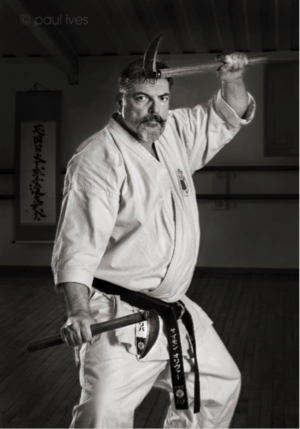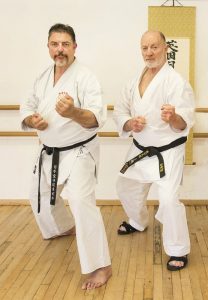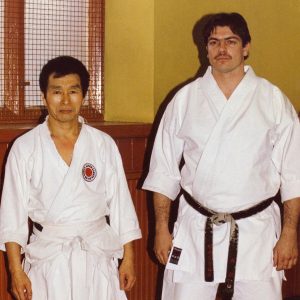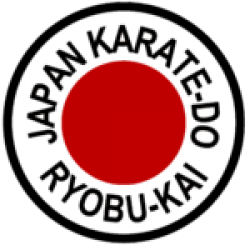The Shotokan Way interview:
Simon Oliver is a pioneer of innovative Kata Application, and has starred in a series of six kata application DVDs – Shotokan Oyo – which have been very well received in the Karate World.

The Shotokan Way: Could you please just tell us a little about how you started karate?
Simon Oliver: My family have been involved with Japanese martial arts for three generations. My Grandfather and father were both exponents of Jujitsu and Judo; I naturally started training with them at the age of four. My father took me to see an exhibition at Alexander Palace in London of karate, which I now know was by some of the senior JKA Sensei in the late 1960’s. Well that was it; I pestered my father to enrol me in a karate school. Unfortunately at that time you had to be sixteen years, so no dojo would accept me. Eventually a Judo friend of my Father who was a Shodan in Wado Ryu agreed to teach me privately. He eventually took me to meet his Sensei, the great Tatsuo Suzuki Sensei. I graded for Shodan with the Wado Ryu in the early 1970’s. It was not until 1975 when I first meet Terry O’Neill Sensei I changed to Shotokan a year later. By that time I had also studied Shukokai, Shito Ryu and Kyokushinkai. Later I was also to study Goju Ryu, Shorin Ryu and Shindo Jinen Ryu.
TSW: Throughout your training career, you have experienced many styles other than Shotokan. Can you please tell us a little about what you have taken from all of the styles you’ve studied, and how you applied that to the karate you practice and teach today?
SO: In the early days I just wanted to train, Style meant very little to me and to a certain extent I still have the same attitude. Dojos were hard to find and I would train at the nearest dojo I could get to. Personally I think there is too much emphasis placed on style. I tended to train with Sensei that inspired me, and there have been many! What is Style? It is nothing more than one man’s methodology, perpetuated by his followers until they develop their own style, SHU HA RA is the true way. The most important thing I have taken from studying Martial Arts is to always look for the positive in every system and avoid the idiots that make outlandish claims about their system being the only true way!
TSW: What was it about Shotokan that was so special that made you want to study it as your main martial art?
SO: It wasn’t the style; it was one Sensei, Terry O’Neill! I still train with him, and I always will! Don’t get me wrong, I think Shotokan taught properly is the perfect base for development as a martial artist and provides a structure that works for me and my students. Sadly there are very few people teaching martial arts properly.

TSW: We recently spoke with Sensei Aidan Trimble, former student of Asano Sensei, and he spoke about the type of training Asano used to develop fighting spirit in his students. What were your experiences with Asano Sensei?
SO: Asano Sensei was a fighter and knew how to get the best out of you! I was only ever a visitor to his dojo; I enjoyed his classes and training with the many great karateka that were in those early classes of the 1970’s. Trimble Sensei was his student and certainly would have had a greater experience of Asano Sensei. Asano Sensei dojo was known for its spirit and certainly fighting spirit was demanded and expected as the true way to train.
TSW: With all of your instructors, one name mentioned throughout is Sensei Terry O’Neill. What was it about his karate that impressed you so much, and how has his teaching affected your karate?
SO: If there is one Karate Master this country has produced that you must train with it is Terry O’Neill Sensei. I was 14 years of age when I first trained with O’Neill Sensei and it was like watching the most dangerous and most beautiful thing all at once. He was effective, technically faultless and could inspire you to look death in the face! He is my Sensei and always will be. Even today I wouldn’t like to have to deal with him. Do you know he was voted by the American Black Belt Magazine (The oldest running martial arts mag) in April 2006 as Toughest Fighter on Planet Earth. Not bad for a sixty year old.
TSW: Of course, you are also recognised as an excellent competitor. Do you feel that modern karate competition has in some way diluted the study of karate as a Budo art?
SO: There is No Budo in modern karate competition! What you have today are great athletes with immense skill. That is how sport should be, I see very few real warriors. Times have changed and if karate is going to survive then it must change. Sadly there are few dojos that teach the old way, I think they would struggle to survive. I try and keep a balance, you have to for safety.
TSW: You are nowadays most famous for your collection of kata application DVD’s. What was your inspiration to want to create a collection such as this, when there are so many kata application books/DVD’s on the market?
SO: Interesting. The DVDs I produced came out on video long before the recent craze on kata centric training and reflect an older way of training that was only ever designed for self-defence. They are over 12 years old and I am about to update them. The original production was not that great. I created them because there was a missing link to most people’s training and some of the things I saw being sold as application and self defence were not only wrong but totally infective and very dangerous.
TSW: Could you please tell us about the differences between Bunkai, Oyo and Henka?
SO: Yamazaki Sensei of the Ryobu-kai, who I represent in the UK describes them as the following:
BUNKAI: Is the breakdown and analysis of the kata.
OYO: These are the real applications
HENKA: These are application variations
There is a third term that is not often heard: KAKUSHI WAZA or the hidden techniques.
TSW: Do you still train under anyone now, even though you are an accomplished karateka?
SO: Yes, I will always be a student, you never stop learning and I will always get in the line. I will train with anybody, and I think my karate is getting better because of it, I hope it is? I still train with O’Neill Sensei. One of the other great influences on my Karate is Dave Hazard Sensei, the man is a technical genius and I am honoured to have been associated with him for over 25 years. I have been spoilt, having been involved with O’Neill Sensei and Fighting Arts Magazine; I have had the privilege to train with many great martial artists from many different disciplines. One the great Sensei I train with is Kiyoshi Yamazaki Sensei 8th Dan of the little known Shindo Jinen Ryu (Ryobu-Kai) when I can get him to the UK and I look forward to seeing him back soon! He is very senior within the WKF. What a lot of Shotokan karate-ka don’t know if it wasn’t for Yamazaki Sensei’s teacher, the legendary Yasuhiro Konishi (1893-1983) there would have been no Shotokan. Funakoshi Sensei opened his first dojo at Keio University in Konishi Sensei’s dojo in September 1924. I have also been very lucky to have some great people locally to train and be guided by, such as Trimble Sensei, Leeshue Sensei and Kenny Johnson the former Shito Ryu Supremo! I miss training with Enoeda Sensei and some of the other great martial artist that are no longer with us. Enoeda Sensei was great man, not just a great karate teacher.

TSW: Karate is becoming much better understood. But, with more people thinking about karate, certain beliefs that once were taken as red are now being questioned. One such example is the contraction of the antagonistic muscles at the end of for example a punch. Master Nakayama for example taught that you should contract the entire muscles of the body at focus. This is currently being disputed. What do you do at focus on a punch? Practice the traditional method, or prefer to keep as relaxed as physically possible throughout?
SO: I think of nothing, I know my punches work; I avoid punching thin air with out using kime as that is bad for your joints. I prefer to punch pads, bags, and people when they let me, Ha Ha!
TSW: Can you please explain some technical points that seem to confuse many students? Could you give us different ways that breathing is used in karate, for example, when punching, kicking and blocking and why breathing accurately in each case is so important.
SO: I have written several articles regarding breathing and it is interesting to note most senior karate masters will tell you the way to effective martial arts is to master the art of breathing. What I have described here are the two main types of breathing used in the Shotokan. There are in fact several ways and schools of breathing that have an influence on karate, but to describe them in detail would take to long for this interview.
Ibuki
It is essential that the respiratory activity during karate training should always be performed in conjunction with the correct delivery of techniques. The state of the body should be relaxed with the breathing natural and not forced before techniques are delivered. The lower diaphragm should be used to stimulate the breathing movement. On performance of techniques the air in the lungs should be strongly and rapidly exhaled. The hara (lower abdominal area) and the muscles needed to deliver the technique should be tensed hard. Kanazawa Sensei recommends that the crown of the head is pushed upwards on the synchronised activity of the movement to get the full health benefits of the delivery. Immediately after impact the body returns to its relaxed state and the whole process should be capable of many repetitions.
Nogare
In Kanazawa Sensei’s book he also describes the correct breathing for mokuso to improve control over ones mental state especially ones emotions. This type of breathing involves the correct kneeling posture of seiza to be mastered. One inhales via the nasal passage in both methods of breathing, which has a mucous membrane and a lining of fine hair which acts as an essential filter, warmer and moisturising system . The stale air is eventually slowly exhaled after it has travelled its circular process route via the mouth. The imagination is called into play when one focus’s on the route of the breath travelling up from the nose via the forehead, to the crown of the head, down the back of the neck, down the spine and eventually circling in the hara. The air uncoils on exhalation up from the hara, travelling past the solar plexus and throat on its way out from the mouth. Nogare breathing is some times described as retreating breathing or relaxing breathing. Variations of these breathing methods do exist from style to style and dojo to dojo. I have taken a simplistic view on the descriptions of theses two types of breathing, an advance practitioner depending on his requirement and stress environment may mix and match these two breathing types. In either method the breath should not be allowed to become shallow our laboured but regular and controlled . Correct breathing is essential to karate not only to gain unity with the actions of the body, but also in the development of a healthy body and mind. Aun no gyo breathing practiced on a daily basis especially early in the day while pollution levels tend to be lower and near a tree producing plenty of oxygen will enhance your ability to train longer with a better level of control. Again this breathing method needs correct supervision and I therefore would recommend to any student wishing to study it, they should seek out a Sensei who can coach them.
TSW: This week, we have heard the awful news of the death of Asai Sensei. He was a pioneer and indeed a fantastic karateka. Without Masters such as himself – but also others such as Enoeda and Kase who have sadly passed in recent years – do you think the Budo attitude will be kept alive, or gradually fade away?
SO: The True Bu spirit will remain amongst those of us still teaching the old way and where the emphasis is on self defence. I am afraid the advent of sport and the influence of the mighty dollar will mean karate must change to survive. It has dramatically changed already with many network marketing schools being set up, with poor quality instruction by people just in the art for the money! There will always be the true way for those that are willing to seek it out. But you average beginner knows not what is good or bad and most people today are satisfied with what I call recreational training. For me the World changed forever the day Enoeda Sensei died. I had trained with both Kase Sensei and Asai Sensei who was both special and great martial artist. Enoeda Sensei was an inspirer of men and was always true to himself, his students and to karate.
TSW: What is your favourite kata and why?
SO: I have three kata that I practise often, Hungetsu, Jitte and Gankaku. They are my favourite Shotokan kata and each has a different importance to me. Hungetsu, I find is a holistic practise and spiritually cleansing. Jitte I like the applications. Gankaku is my personal Mt. Fuji, Some days it’s easier than others. But that is also how I feel about my karate, some days it’s easier than others!

